





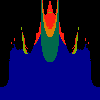






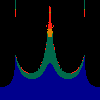
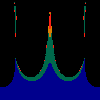

Well, the base looks pretty darn circular, right? Its not. It's ever so
slightly eccentric (nothing in life is easy). The shape is given by
the often quoted "cardiod",
z = 0.5 * exp (i*phi) - 0.25 * exp (2*i*phi),
which, in our coordinate system,
K = 0.5 * sqrt (1.25 - cos(phi)) and
theta = arctan ( (sin(phi) - 0.5*sin(2*phi)) / (cos(phi) - 0.5*cos(2*phi))).
In this coordinate system, the cardiod is very nearly a circle,
to within about 1% of the radius
(graph),
which I find to be a curious fact not to be forgotten when trying to find the
shapes of things.
c = K eit - K2 e2it
Thus we see the main cardiod lie below the straight line K=1/2. (and a reflected image above it at t=0, which is where the horn/butt maps to).
z <-- z*z + c == (x+i*y)*(x+i*y) + Re(c) + i*Im(c) == x*x - y*y + Re(c) + i * (2*x*y + Im(c))we play with the cross term ...
z <-- z*z + c == (x+i*y)*(x+i*y) + Re(c) + i*Im(c) == x*x - y*y + Re(c) + i * (2*x*y(1.0-lambda) + Im(c))In the sequence below, we see lambda go from 0.1 to 1.0, in steps of 0.1. Click on the prictures with the big borders.








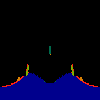
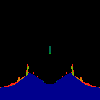
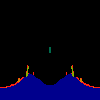
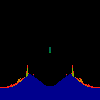
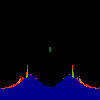
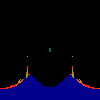
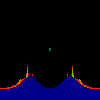

Hacked Mandelbrot
by Linas Vepstas is licensed under a
Creative Commons
Attribution-ShareAlike 4.0 International License.